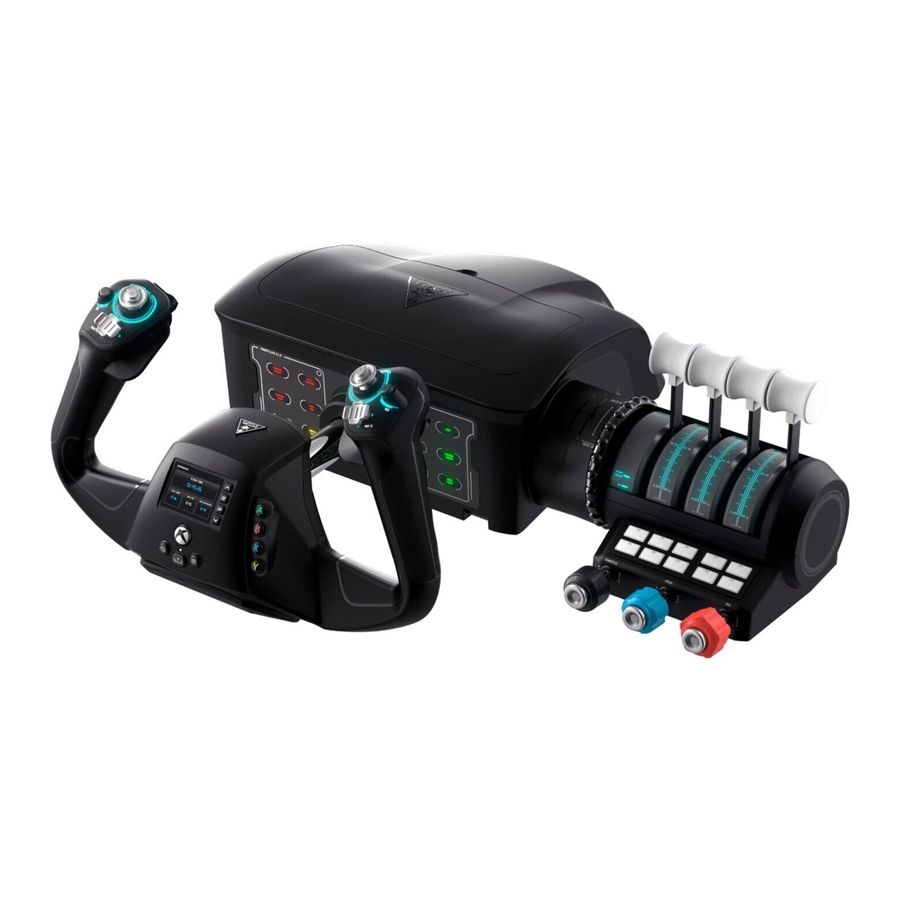
Turtle Beach Velocityone Flight - Flight Simulator Manual
- Quick start manual (15 pages)
Advertisement

INTRODUCTION
Welcome to the VelocityOne Flight. It has been designed to be used across a wide range of flight simulation scenarios. This guide will help get you up and running and start you on your Microsoft Flight Simulator experience. Please visit our knowledgebase at turtlebeach.com/support for additional information and notifications on product updates.
HARDWARE SETUP, CONTROLS & FEATURES
- ATTACH QUADRANT MODULE
![]()
-
- CLAMP TO DESK
![]()
- ALTERNATIVELY SECURE USING SUCTION TAPE
The Yoke can also be attached to existing cockpit setups using the supplied screws. Please visit our knowledgebase at turtlebeach.com/support to find screw hole templates and dimensions.
![]()
- CLAMP TO DESK
- CONNECT CABLES
![]()
- CHOOSE INPUT MODE
SELECT INPUT MODE FROM MAIN MENU WITH![]()
PRESS![]() TO VIEW
TO VIEW
SELECT XBOX OR PC WITH![]()
PRESS![]() TO SAVE
TO SAVE
![]()
- DOWNLOAD TURTLE BEACH CONTROL CENTER
FOR FEATURE AND PERFORMANCE UPDATES ON WINDOWS AND XBOX
![]()
![]()

- YOKE HANDLE
Used for all main flight adjustments:
- Yoke left/right - Controls the Ailerons. These are located on the wings and rolls the plane left or right.
- Yoke forward/back - Controls the Elevators. These are located on the tail and pitches the nose up or down.
- Rear Triggers - Controls to the rudder, located on the tail of the plane. The rudder yaws the aircraft, to assist with turns during flight and whilst on the runway.
- STATUS INDICATOR PANEL (SIP)
Consists of 12 x LEDs that react to events in Microsoft Flight Simulator. If a low fuel warning goes off, or if you want to check the status of your landing gear, the SIP can tell you. The SIP mode can also be set to match the rest of the LED colours on the product. - MENU CONTROLS
VelocityOne Flight includes all the core controls for easy Xbox OS and menu 2 navigation. POV-I acts as the D-Pad for selecting menus and also cursor mode within Microsoft Flight Simulator. - FLIGHT MANAGEMENT DISPLAY (FMD)
Access enhanced features and settings. The FMD has 5 core features:
- Select Input Mode for compatibility across Xbox and Windows PC.
- Quickly select and activate pre-made profiles for Microsoft Flight Sim. Saving you setup time.
- Provides additional training support by displaying profile assignments.
- Provides flight chronometer information, including local time, and the ability to time each section of a flight to assist with navigation.
- View and adjust core hardware settings, such as LED colour and brightness.
- QUADRANT BUTTONS
Additional buttons that can be assigned to any function within Flight Sim.
- Ideal for toggling landing gear, parking brakes and other flight systems.
- Use the included set of decals to label the buttons for easy reference.
- TRIM WHEEL
Used to maintain level flight without needing to keep your hands on the Yoke. Use the Yoke handle to get the plane level, and then use the wheel to make fine adjustments to nose up/down position. - QUADRANT LEVERS
Replicate the engine controls used across a wide range of aircraft.
- Ideal for controlling the thrust levels of individual engines on multi-engine planes.
- They can also be used for more realistic control of Flaps and Spoilers, to assist with take off and landing.
- Levers can be customized using the additional handles supplied.
- TPM VERNIER LEVERS
Replicate the engine controls used on light aircraft such as Cessna 152. All are set to max for take off, and can be reduced at cruising altitude.
- Throttle (Black) - Adjusts the thrust output of an engine by varying the RPM.
- Propeller (Blue) - Alters the tilt angle of the propeller blades.
- Mixture (Red) - Regulates the ratio of fuel to air supplied to the engine.
HOW DOES THE YOKE AFFECT THE MOVEMENT OF A PLANE?

BOX CONTENTS

Now that you have the hardware setup, we will cover off the basics to get you flying in Microsoft Flight Simulator.
DEFAULT FLIGHT SIMULATOR CONTROLS
If you are new to Flight Simulator, we recommend using the Default profile, and running through the Flight Training lessons. The Default profile contains everything you need to get flying, and will be active when you first connect the product and load the simulator.


ACTIVATE A PROFILE USING THE FMD
 MENU UP
MENU UP
 SELECT
SELECT
 BACK
BACK
 MENU DOWN
MENU DOWN
- SELECT PROFILE FROM THE FMD MAIN MENU
![]()
- HIGHLIGHT AND ACTIVATE DEFAULT PROFILE.
![]()
- SELECT TRAINING FROM THE FMD MAIN MENU.
![]()
- MOVE AN AXIS OR PRESS A BUTTON TO SEE WHAT IT DOES IN MICROSOFT FLIGHT SIMULATOR.
![]()
START FLYING IN MICROSOFT FLIGHT SIMULATOR
- ACCESS THE CONTROLS OPTIONS TO CHECK DEFAULT PROFILE IS ACTIVE.
![]()
- GO TO WORLD MAP TO SELECT YOUR PLANE AND FLIGHT PLAN.
![]()
- SET CONTROLS FOR TAKEOFF.
![]()
- DISENGAGE PARKING BRAKE.
![]()
- THROTTLE UP
![]()
- GENTLY PULL BACK ON YOKE TO TAKE OFF
![]()
- RETRACT LANDING GEAR AND FLAPS
![]()
- GENTLY PUSH FORWARD ON YOKE TO LEVEL OFF
![]()
Some features are only compatible with Microsoft Flight Simulator on Xbox and Windows 10 Not all features available at launch.
New features will be added via software and firmware updates.
Documents / Resources
References
Download manual
Here you can download full pdf version of manual, it may contain additional safety instructions, warranty information, FCC rules, etc.
Download Turtle Beach Velocityone Flight - Flight Simulator Manual
Advertisement





 TO VIEW
TO VIEW















Need help?
Do you have a question about the Velocityone Flight and is the answer not in the manual?
Questions and answers